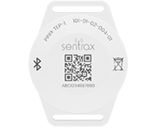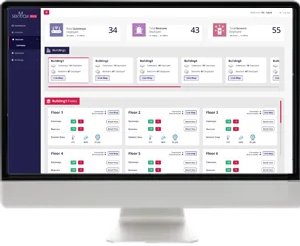- Scanners/Locators
BLE RSSI Scanners & Locators
BLE (RSSI) based indoor locator and gateway that provides proximity positioning, presence & environmental sensing.
BLE (RSSI)-based indoor locator and gateway that provides proximity positioning.
BLE (RSSI)-based outdoor locator and gateway that provides proximity positioning with Wi-Fi, LTE connectivity, and GPS positioning.
BLE AoA Scanners & Locators
BLE (AoA)-based indoor locator and gateway that provides precise submeter location tracking.
BLE (AoA)-based outdoor locator and gateway that provides precise sub-meter location tracking.
- Beacons/Tags
BLE (AoA) Asset Tag with Multi-Sensors
Hybrid BLE (AoA) & (RSSI) Asset Tag
Smart Badge BLE (AoA) Tag with Temperature Sensor
Outdoor Anchor BLE Beacon Tag with Internal Temperature Sensor
BLE (RSSI) Wearable Bracelet Beacon Tag for Persons Positioning
Indoor Anchor BLE Beacon Tag with Temperature Sensor
- Software
SENTRAX’s versatile platform for asset and personnel management, available in API, on-premise, and cloud-based versions.
Simplifies and enhances the configuration & management of BLE beacon tags, available on both Android and iOS.
Provides a versatile set of functionalities to support location-based systems in various smartphone applications, facilitating indoor positioning.
- Evaluation Kit
BLE (RSSI) Evaluation Kit for real-time proximity positioning and tracking of nearby assets and personnel. Try this evaluation kit for deployment and testing.
BLE (AoA) Evaluation Kit for precise real-time positioning and tracking of assets and personnel. Try this evaluation kit for deployment and testing.

- BLE RSSI RTLS
- BLE AoA RTLS
- Environmental Sensing
BLE RSSI – Proximity Positioning & Tracking System
Indoor positioning and tracking are crucial in sectors like retail, healthcare, logistics, and smart buildings. The Received Signal Strength Indicator (RSSI) is vital for estimating the location of BLE devices indoors. Its simplicity allows for widespread adoption in various wireless devices. Distance calculation involves measuring the signal strength of received packets, determining the distance between a transmitter and a receiver by observing signal strength decrease as the signal moves away from the transmitter.
Whether used in a large warehouse or a small retail store, the principles of Bluetooth RSSI based tracking are straightforward. To effectively track all necessary assets within a facility, the following components of the system must be in place:
- Devices such as tags capable of transmitting BLE signals.
- Dedicated receivers or gateways designed to receive signals from the tags.
- Specialized RTLS (Real-Time Location System) software, RTLS and IoT Management Platform, which can process all collected data and present it in an easily understandable format.
Technology Benefits
Bluetooth 5.0 Technology
The technology is based on the 5.x version of Bluetooth, which offers reliable range and accuracy.
Proximity Tracking:
Utilize RSSI (Received Signal Strength Indicator) technology to achieve tracking and positioning of objects, people, or assets.
Environmental Sensing:
Real-time visibility of sensor data to monitor humidity, temperature, air quality, and pressure with dedicated sensors on the BLE locator/gateways.
Presence Sensing:
Real-time detection of personnel motion by sensing their presence and absence.
Locators and Beacons
system includes fixed locators and beacons attached to the object being tracked, making it ideal for asset tracking in warehouses.
Deployment & Configuration:
Perform live single or bulk device configurations for gateways, beacons, and sensors.
Real-time Visibility:
Access and analyze location data with the powerful and user friendly Solix Suite Platform.
Enhanced Operations:
Optimize processes, improve efficiency, and boost safety & security.
Cost-Effectiveness:
Implementing RSSI-based systems typically requires minimal additional hardware, leveraging existing infrastructure of devices with wireless communication capabilities.
Bluetooth Low Energy – Angle of Arrival – Real-time Location Systems
Angle of Arrival (AoA) RTLS Technology:
Precise & Reliable Indoor Positioning
Bluetooth Low Energy (BLE) Angle of Arrival (AoA) technology is an innovative solution for accurate real-time location and environmental monitoring. The AoA method uses both the signal strength and angle of arrival to determine the precise location of objects and individuals.
Locating & Positioning with AOA
- Signal strength tells us roughly how far away they are
- Item finding requires an experimental approach
- When we don’t know the direction of the lost item!
- We have no idea what direction one is from the other
- Knowing direction improves location accuracy
- The user experience is considerably better when
- We can indicate the direction to walk in!
Technology Benefits
High-Accuracy RTLS
AoA based positioning is used for high-accuracy real-time location systems (RTLS) with a range of 0.1-1m.
Bluetooth 5.1 Technology
Bluetooth 5.1 technology is used to implement the AoA method.
Precise Location Tracking
The AoA method use angles to determine the exact location of an object.
Locators and Beacons
Our system includes fixed locators and beacons attached to the object being tracked, making it ideal for asset tracking in warehouses.
Robust in All Environments: The technology works effectively even in environments with significant signal interference.
Cost-Effective & Versatile
No additional hardware is required, and the system can be used for a variety of applications such as location tracking, employee monitoring, wayfinding, and automation.
Real-time Environmental Sensing
Our RTLS systems also provide real-time temperature, pressure, humidity, and air quality data.
Affordable Accuracy
Our Sentrax RTLS solution offers cost-effective and precise indoor positioning and environmental sensing.
AoA Technology is commonly used in asset tracking in warehouses where locators are placed throughout the warehouse and use beacon identification numbers to locate items.
Versatility
BLE AoA RTLS can be used for a variety of applications, including location tracking, employee monitoring, way finding, and automation.
Choose Sentrax for all your RTLS needs and experience the difference of high-accuracy, cost-effective indoor positioning.
Bluetooth Low Energy – Environment Sensing
Environmental sensing plays an important role in various industries and facilities, including smart buildings, healthcare, and industrial environments. The following are some of the key benefits of incorporating environmental sensing into a location tracking system.
Bluetooth Low Energy (BLE) environment sensing is a technology that allows real-time monitoring and tracking of environmental parameters such as temperature, pressure, humidity, and air quality. BLE sensor beacons communicate with a central hub or gateway, which collects and analyzes the data, providing real-time information about the environment.
Bluetooth Low Energy (BLE) Environmental Sensing technology is used to monitor various physical parameters such as:
Temperature
Real-time temperature monitoring of a specific area or object
Humidity
Continuous measurement of relative humidity levels in a room or environment
Air Quality
Monitoring of air quality parameters such as volatile organic compounds (VOCs), carbon dioxide (CO2), and particulate matter (PM2.5 and PM10)
Pressure
Measuring barometric pressure to monitor atmospheric conditions
Light
Monitoring of light intensity and color temperature to optimize lighting conditions in indoor environments
These parameters provide valuable information about the environmental conditions, which can be used for various purposes such as:
- Indoor air quality improvement: Monitoring and controlling indoor air quality parameters can improve health and comfort.
- Building automation: Real-time temperature, humidity, and air quality data can be used to control HVAC systems, ensuring optimal indoor conditions.
- Predictive maintenance: Monitoring environmental parameters can provide early warning signs of potential equipment failures, allowing for timely maintenance.
- Energy Management: Monitoring temperature and humidity can help to optimize energy consumption and reduce energy costs.
- Health and safety: Monitoring air quality parameters can help to identify and mitigate potential health hazards, ensuring a safe and healthy indoor environment.
This technology has a number of benefits, including:
- Real-time monitoring: BLE environment sensing provides real-time data about environmental conditions, allowing for quick and effective response to changes.
- Improved safety: By monitoring environmental parameters, such as temperature and humidity, BLE environment sensing can help ensure that conditions are safe for people, animals, and equipment.
- Energy efficiency: BLE technology is designed to be energy efficient, reducing the cost of monitoring and reducing the risk of battery failure in sensors.
- Easy integration: BLE sensors and beacons can be easily integrated with existing systems, making it a cost-effective solution for environment sensing.
- Versatile applications: BLE environment sensing can be used in a variety of applications, including industrial facilities, smart buildings, and agriculture.
Overall, BLE environment sensing provides a cost-effective, reliable, and energy-efficient solution for real-time monitoring and tracking of environmental parameters.



















